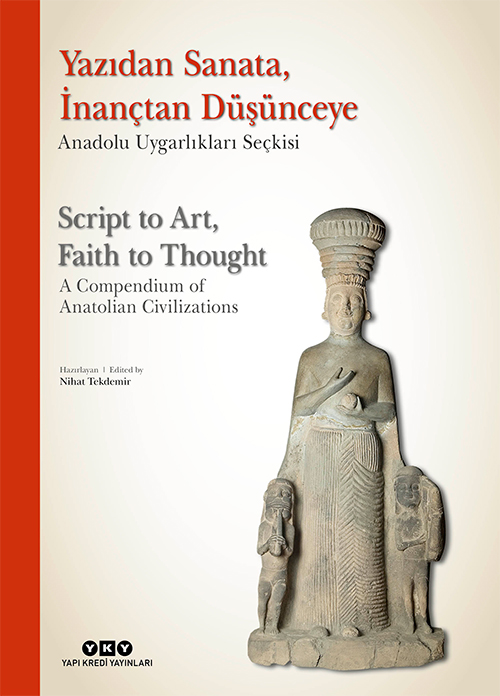Preview

Julia Braungart,Studien zur frühkupferzeitlichen Foeni-Gruppe im südwestlichen Rumänien anhand der Gefäßkeramik aus Foeni-Cimitirul OrtodoxCluj – Napoca 2022ISBN 978-606-020-444-2626 S./pp., zahlr. Farb- und S/W-Abb./num colour and b/w-figs., 29,7 x 21 cm; kartoniert/hardcover

Salvator Žitko – Brigitta Mader,Med Benetkami in Dunajem [Zwischen Venedig und Wien]Kulturna dediščina kot predmet nacionalnega prestiža in istrske identiteteKoper – Capodistria 2025ISBN 978-961-6732-71-0252 S./pp., zahlr. Farb- und S/W-Abb./num colour and b/w-figs., 29,7 x 21 cm; kartoniert/hardcover slowenisch (S. 1 - 176) und deutsch (S. 177 - 234) Das Buch „Zwischen Venedig und Wien“ von Salvator Žitek und Brigitte Mader enthüllt eine lange verborgene Geschichte über das Schicksal des kulturellen Erbes Istriens und der Küste während der Evakuierungen in Kriegszeiten und der politischen Umsiedlungen nach dem Krieg und wirft wichtige Fragen zum Denkmalschutz und zur gemeinsamen Verantwortung im heutigen Europa auf. In der Studie „Zwischen Venedig und Wien“, die das Ergebnis ihrer langjährigen Forschung auf dem Gebiet des Kulturerbeschutzes im Gebiet der ehemaligen österreichischen Küste, später der Julischen Alpen und heute insbesondere Istriens mit seinem nahen Hinterland ist, befassen sich die Autoren mit Fragen im Zusammenhang mit der Haltung der jeweiligen Regierungsstrukturen gegenüber beweglichem Kulturgut, aber auch mit den Massenevakuierungen zwischen 1940 und 1944 von wertvollen Kunstwerken, archäologischem Material, Archiven und individuellen Büchersammlungen, insbesondere aus Koper und Piran, die nach 1945 und 1954, als sich die politischen Grenzen änderten, auf italienischem Boden verblieben und Gegenstand zwischenstaatlicher Verhandlungen und Restitutionsforderungen wurden. Aufgrund der noch immer ungelösten Probleme und der unterschiedlichen Ansichten von Fachkreisen beiderseits der ehemaligen Grenze ist die Monographie äußerst aktuell und wichtig für einen umfassenderen Einblick in diese Thematik, auch für die breite Öffentlichkeit und verantwortliche Kreise, da sie zu einer nachdenklichen Reflexion im Kontext gemeinsamer Anstrengungen und der Pflege von Werten im Rahmen der heutigen Europäischen Union anregt.

Προσόδια: Μελέτες για τις αρχαίες λατρείες προς τιμήν του Μανόλη Βουτυρά / Prosodia. Studies on Greek and Roman Cults in Honour of Emmanuel VoutirasAthen 2025ISBN 978-960-386-731-9XXX + 497 S./pp., zahlr. S/W-Abb. / num. b/w-figs., 29,7 x 21 cm; kartoniert/hardcover

Aykut Şengözer – Aslı Özbay (eds.),Barbarossa’s Çinili Hamam: A Masterpiece by SinanIstanbul 2023ISBN 978-625-7008-72-3344 S./pp., zahlr. Farbabb./num. colour-figs., 29 x 23 cm; kartoniert/hardcover Published simultaneously with the opening of Zeyrek Çinili Hamam, Barbarossa’s Çinili Hamam: A Masterpiece by Sinan is an invaluable reference chronicling the five-century story of this magnificent cultural heritage site from its construction to the present day as well as the striking aspects that distinguish it from similar structures. Once standing gloriously in Zeyrek that was a prominent district during both Byzantine and Ottoman periods, the hammam afterwards was lost to oblivion behind modern buildings. Product of a two-year painstaking work, the book offers new information that came into light during the thirteen-year-long restoration on top of the already existing academic sources. The articles penned by scholars and experts offers an insight and illuminating information from the sociological aspect of the hammams to Çinili Hamam’s tiles and ornamentation program, from its restoration process to the splendid hammamiye tiles and the journey of its tiles that were sold in Europe in the 19th century. The book is equally absorbing for both academics and readers that take interest in architecture and history. Edited by Aykut Şengözer and Aslı Özbay and designed by Yeşim Demir Pröhl, the book features articles by Leyla Kayhan Elbirlik, Cengiz Kabaoğlu, Bora Keskiner, Tim Stanley, Yavuz Suyolcu, M. Baha Tanman and Filiz Yenişehirlioğlu and photographs by Murat Germen and Orhan Cem Çetin that bring out the beauty of every part of the hammam.

Nihat Tekdemir (ed.),Script to Art, Faith to Thought – A Compendium of Anatolian CivilizationsIstanbul 2025ISBN 978-975-08-6623-4 (paperback) ISBN 978-975-08-6624-1 (hardcover) XX + 396 S./pp., zahlr. Farb- und S/W-Abb./num. colour and b/w-figs., 33 x 23,5 cmzweisprachig englisch – türkischbilingual english – turkish

Bilal Söğüt (ed.), Muğla Kazı ve Araştırmaları IAnkara 2025 ISBN 978-625-6925-91-5XII + 421 S./pp., zahlr Farb- und S/W-Abb./num. colour and b/w-figs., 29,7 x 21 cm; kartoniert/hardcover
